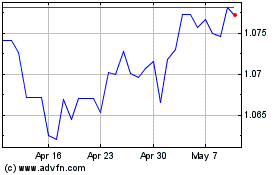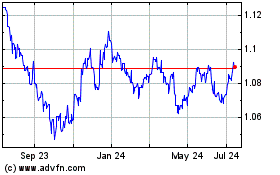Dollar Pulls Back As Soft Jobs Data Adds To Rate Cut Hopes
September 06 2019 - 6:13AM
RTTF2
The U.S. dollar moved off from its early highs against its major
counterparts in the European session on Friday, as U.S. job growth
accelerated less than forecast in August, supporting the likelihood
of an additional rate cut by the Federal Reserve this month.
Data from the Labor Department showed that the non-farm payroll
employment rose by 130,000 jobs in August after climbing by a
downwardly revised 159,000 jobs in July.
Economists had expected employment to increase by about 158,000
jobs compared to the addition of 164,000 jobs originally reported
for the previous month.
The Labor Department also said the unemployment rate held at 3.7
percent in August, unchanged from July and in line with economist
estimates.
Today's jobs data undermined optimism triggered by the
better-than-expected ISM nonmanufacturing gauge and the Automatic
Data Processing's private sector payrolls numbers for August on
Thursday.
Traders are also likely to keep an eye on remarks by Federal
Reserve Chairman Jerome Powell on the economy and monetary policy
at an event in Zurich.
The greenback showed mixed trading against its major
counterparts in the Asian session. While it held steady against the
euro and the yen, it rose against the franc. Against the pound, it
declined.
The greenback dropped to 0.6847 against the aussie, its weakest
level since August 1. Should the greenback slides further, 0.71 is
possibly seen as its next support level.
The greenback depreciated to more than a 2-week low of 0.6431
against the kiwi from Thursday's closing value of 0.6373. The
greenback is seen finding support around the 0.66 level.
The greenback slipped to more than a 4-week low of 1.3179
against the loonie, from a high of 1.3240 it recorded at 8:30 am
ET. The currency is likely to find support around the 1.30
level.
After rising to a 3-day high of 0.9918 against the franc at 7:30
am ET, the greenback eased off slightly to 0.9875. Next likely
support for the greenback is seen around the 0.97 level.
The greenback edged lower to 1.1055 against the euro, from a
high of 1.1020 seen at 7:30 am ET. Further downward trading may
take the greenback to a support around the 1.13 level.
Data from Destatis showed that Germany's industrial production
declined unexpectedly in July, adding fuel to worries that the
biggest euro area economy entered a recession in the third
quarter.
Industrial production fell 0.6 percent in July from June,
confounding expectations for an increase of 0.3 percent.
Nonetheless, the pace of decline slowed from the 1.1 percent fall
in June.
The greenback weakened to 106.65 against the yen, after having
climbed to 107.10 at 10:15 pm ET. The greenback is poised to
challenge support around the 104.00 level.
Preliminary data from the Cabinet Office showed that Japan's
leading index remained unchanged in July.
The leading index, which measures the future economic activity,
came in at 93.6 in July, unchanged from June. Economists had
forecast a reading of 93.2.
The greenback pulled back to 1.2336 against the pound, from a
high of 1.2285 it recorded at 4:45 am ET. Further downtrend is
likely to take the greenback to a support around the 1.27
level.
Survey data from IHS Markit and Lloyds Banking subsidiary
Halifax showed that UK house prices rose for a second straight
month in August, after stagnation in June, and the annual rate of
increase was the highest in four months.
The Halifax house price index rose 0.3 percent from July, when
they were 0.4 percent higher. Economists had forecast a 0.2 percent
increase.
Looking ahead, Canada Ivey PMI for August will be featured
shortly.
Euro vs US Dollar (FX:EURUSD)
Forex Chart
From Mar 2024 to Apr 2024

Euro vs US Dollar (FX:EURUSD)
Forex Chart
From Apr 2023 to Apr 2024
